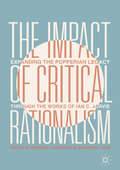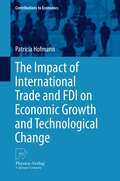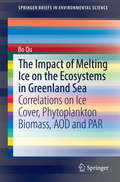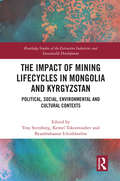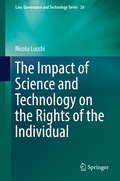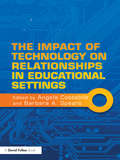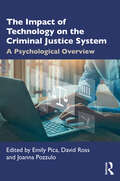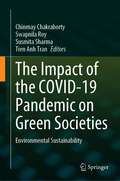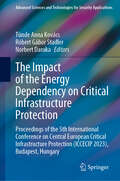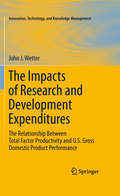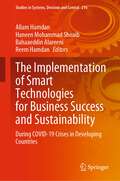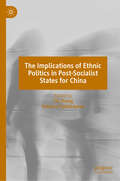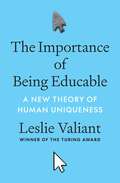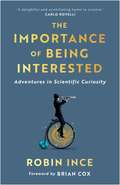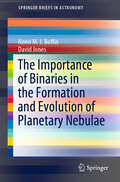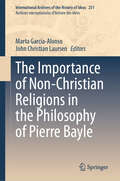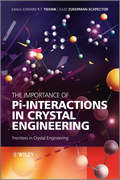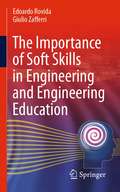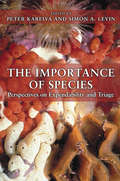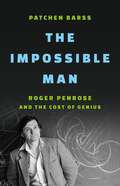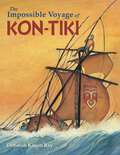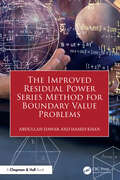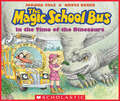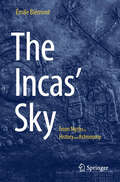- Table View
- List View
The Impact of Critical Rationalism: Expanding the Popperian Legacy through the Works of Ian C. Jarvie
by Raphael Sassower Nathaniel LaorAs a student and disciple of Karl Popper and longtime managing editor of Philosophy of the Social Sciences, Ian C. Jarvie extended the notion of Critical Rationalism to be useful in anthropology, aesthetics, film studies, and various social sciences. In this Festschrift, contributors from a range of interests and disciplines engage with the Popperian legacy and Jarvie’s scholarly and editorial work in Critical Rationalism to contextualize it in the broader, contemporary intellectual landscape. These original essays not only honor Jarvie’s legacy, but expand it to cross the philosophical divide between analytic and continental schools of thought. In so doing, the authors bring the state-of-the-art achievements of Critical Rationalism to the forefront of current academic debates.
The Impact of Discovering Life Beyond Earth
by Steven J. DickThe search for life in the Universe, once the domain of science fiction, is now a robust research program with a well-defined roadmap, from studying the extremes of life on Earth to exploring the possible niches for life in the Solar System and discovering thousands of planets far beyond it. In addition to constituting a major scientific endeavor, astrobiology is one of the most popular topics in astronomy, and is of growing interest to a broad community of thinkers from across the academic spectrum. In this volume, distinguished philosophers, theologians, anthropologists, historians and scientists discuss the big questions about how the discovery of extraterrestrial life, whether intelligent or microbial, would impact society. Their remarkable and often surprising findings challenge our foundational concepts of what the discovery of alien life may hold for humankind. Written in easily accessible language, this thought-provoking collection engages a wide audience of readers from all backgrounds.
The Impact of International Trade and FDI on Economic Growth and Technological Change
by Patricia HofmannEconomic globalisation and technological change are the two issues that concerned people in the past, concern them today and will concern them in the future - all over the world, poor or rich. Traditionally, questions about allocative effects are asked: What are the labour market implications? Who loses? Who wins? What is the net aggregate welfare effect after an adjustment period? However, two points are rarely taken into consideration: How do globalisation and technological change interact and what are the potential long-run implications for economic growth? This book addresses the interplay of these megatrends. It asks how economic globalisation may affect innovation and technology of individual firms and eventually the growth prospects of countries. Thereby it shows that protectionism not only harms static efficiency but might as well lead to dynamic losses. The book provides a systematic overview of the theoretical underpinnings of the openness-growth nexus and summarises the conceptual problems and important findings of the empirical analyses so far. The theoretical insights are supported by two empirical studies, the first dealing with the innovative behaviour and the "within-multinational" technology transfer of Spanish firms that were acquired by foreign companies and the second analysing productivity growth rate implications from exporting for German manufacturing firms.
The Impact of Melting Ice on the Ecosystems in Greenland Sea
by Bo QuArctic marine ecosystems are largely impacted by changes associated with global warming. The sea ice in Greenland Sea plays an important role in regional and global climate system. The book investigate the relationships between phytoplankton biomass, measured using remotely sensed chlorophyll-a (CHL), aerosol optical depth (AOD) and sea-ice cover (ICE) in the Greenland Sea (20°W-10°E, 65-85°N) over the period 2003-2012. First hand Satellite data was used to do correlation analysis. Enhanced statistics methods, such as lag regression method and cointegration analysis method are used for correlation and regression analysis between 2 variables (up to 3 variables). ARMA model was used to prediction time series in the future 3 years. The book not only gives outline of ecosystem in Greenland Sea, how the ice impact to the local ecosystems, but also provides valuable statistical methods on analysis correlations and predicting the future ecosystems.
The Impact of Mining Lifecycles in Mongolia and Kyrgyzstan: Political, Social, Environmental and Cultural Contexts (Routledge Studies of the Extractive Industries and Sustainable Development)
by Troy SternbergThis volume investigates how mining affects societies and communities in Mongolia and Kyrgyzstan. As ex-Soviet states, Mongolia and Kyrgyzstan share history, culture and transitions to democracy. Most importantly, both are mineral-rich countries on China’s frontier and epi-centres of resource extraction. This volume examines challenges communities in these countries encounter on the long journey through resource exploration, extraction and mine closure. The book is organised into three related sections which travel from mine licensing and instigation to early anticipation of benefit through the realisation of social and environmental impacts to finite issues such as jobs, monitoring, dispute resolution and reclamation. Most originally, each chapter will include a final section entitled ‘Notes from the Field’ that presents the voice of in-country researchers and stakeholders. These sections will provide local contextual knowledge on the chapter’s theme by practitioners from Mongolia and Central Asia. The volume thereby offers a distinctively grounded perspective on the tensions and benefits of mining in this dynamic region. Using Mongolia and Kyrgyzstan as case studies, the volume reflects on the evolving challenges communities and societies encounter with resource extraction worldwide. The book will be of great interest to students and scholars of mining and natural resource extraction, corporate social responsibility and sustainable development.
The Impact of Science and Technology on the Rights of the Individual
by Nicola LucchiThevolume is devoted to the relevant problems in the legal sphere, created andgenerated by recent advances in science and technology. In particular, itinvestigates a series of cutting-edge contemporary and controversialcase-studies wherescientific and technological issues intersect withindividual legal rights. The book addresses challenging topics at theintersection of communication technologies and biotech innovations such asfreedom of expression, right to health, knowledge production, Internet contentregulation, accessibility and freedom of scientific research.
The Impact of Technology on Relationships in Educational Settings
by Barbara A. Spears Angela CostabileAs the linguistic, cognitive and social elements of our lives are transformed by new and emerging technologies, educational settings are also challenged to respond to the issues that have arisen as a consequence. This book focuses on that challenge: using psychological theory as a lens to highlight the positive uses of new technologies in relationships and educational settings, and to advocate technological learning opportunities and social support where the misuse and abuse of ICT occurs. The Impact of Technology on Relationships in Educational Settings sets out to explore the role of ICTs in relationship forming, social networking and social relationships within our schools and has grown out of the European Cooperation in Science and Technology (COST); Action on cyberbullying, involving 28 participating countries, and two non-COST countries, of which Australia is one. This cutting edge international text offers cross-cultural, psychological perspectives on the positive uses of new and emerging technologies to improve social relationships and examples of best practice to prevent virtual bullying. This comes at a time when much of the focus in current writings has been on the more negative aspects which have emerged as new technologies evolved: cyberbullying, cyber-aggression and cybersafety concerns. This text is ideally suited to researchers and practiitioners in the fields of Educational and developmental psychology, as well as those specialising in educational technology and the sociology of education.
The Impact of Technology on the Criminal Justice System: A Psychological Overview
by David Ross Joanna Pozzulo Emily PicaThis comprehensive volume explores the impact of emerging technologies designed to fight crime and terrorism. It first reviews the latest advances in detecting deception, interrogation, and crime scene investigation, before then transitioning to the role of technology in collecting and evaluating evidence from lay witnesses, police body cameras, and super-recognizers. Finally it explores the role of technology in the courtroom with a particular focus social media, citizen crime sleuths, virtual court, and child witnesses. It shines light on emerging issues, such as whether new norms have been created in the emergence of new technologies and how human behaviour has shifted in response. Based on a global range of contributions, this volume provides an overview of the technological explosion in the field of law enforcement and discusses its successes and failures in fighting crime. It is valuable reading for advanced students in forensic or legal psychology and for practitioners, researchers, and scholars in law, criminal justice, and criminology.
The Impact of the COVID-19 Pandemic on Green Societies: Environmental Sustainability
by Chinmay Chakraborty Swapnila Roy Susmita Sharma Tien Anh TranThis book covers the sustainability issues of a green environment towards economics and society in terms of alteration in industrial pollution levels, effect of reduced carbon emissions, changes in water bodies characteristics with respect to heavy metal contamination, monitoring of associated impact with respect to ecology and biodiversity, impact of reduced noise levels and air quality influences on human health, handling and management of biomedical waste. According to WHO, 80% of people living in urban areas are exposed to air exceeding safe limits. The advent of "sustainability‟ in development science has led planners to apply evolving notions of "sustainability‟ to the contemporary debate over how cities and regions should be revitalized, redeveloped, and reformed. Market allocation of resources, sustained levels of growth and consumption, an assumption that natural resources are unlimited and a belief that economic growth will „trickle down‟ to the poor have been its hallmarks. The recent advance technology helps to promote green and clean modern societies continuously. The Internet of things will be playing an important role in the upcoming years in environment protection and sustainable development. There is a focus on paradigm shift in the sustainable development for the green environment during the period of isolation of COVID-19. This is the moment for the mobilization against the climate crisis. The sudden fall in pollutants and subsequent blue skies signifies a dramatic shift for India and also other affected countries during this period. Fighting climate change requires a collaborative approach between all spheres of society unlike the former. It must heavily redirect resources towards local, sustainable activities, including education, health, sustainable agriculture and circular management of resources. The impact of COVID-19 pandemic which has resulted in the dramatic change in the different aspects of the environment. The global lockdown has led to a rejuvenation of nature, ecosystems, biodiversity. Even urban environments are discovering a degree of peace and serenity, which led to decrease in greenhouse gas emission.
The Impact of the Energy Dependency on Critical Infrastructure Protection: Proceedings of the 5th International Conference on Central European Critical Infrastructure Protection (ICCECIP 2023), Budapest, Hungary (Advanced Sciences and Technologies for Security Applications)
by Tünde Anna Kovács Norbert Daruka Róbert Gábor StadlerThis book presents cutting-edge research on the impact of energy dependence and strategies to mitigate it. As a crucial component of critical infrastructure, energy security is a top priority for nations worldwide. The protection of this infrastructure, along with the latest research tools and methodologies, is of significant interest to both policymakers and industry leaders. The book delves into two primary areas of research: cybersecurity and physical security, summarizing the latest findings in these critical fields. The papers in this volume offer valuable insights for both academic and industrial audiences, addressing the pressing challenges of energy security. Energy is integral to every aspect of our daily lives. Our comfort, as well as our safety, hinges on the uninterrupted supply of energy. Recent global events, particularly the Russian-Ukrainian war, have underscored the vulnerability of nations lacking sufficient energy resources. Europe's energy supply has been severely disrupted by sanctions, highlighting the need for energy resilience. However, this crisis has also accelerated the adoption of renewable energy sources, marking a pivotal shift towards sustainable energy solutions.
The Impacts of Research and Development Expenditures
by John J. WetterThe research underlying this volume was designed to test the theory of Total Factor Productivity (TFP) in contemporary context. Developed by Nobel Prize-winning economist, Robert Solow, in the 1950s, TFP has been applied by many economists to investigate the relationships among capital, labor, and economic performance. In this analysis, John Wetter presents the hypothesis that technological investment drives growth and performance of the U.S. economy. The study addresses four key questions: 1. Is there a relationship between Total Factor Productivity and Gross National Product? 2. Is there a relationship between Total Factor Productivity and Research & Development expenditures? 3. Is there a relationship between Research & Development expenditures and Gross Domestic Product? 4. Can the relationship in research question #1 be explained by other factors? Is there any potential non-spuriousness (mediation) implication to the relationship? Synthesizing the literature from related fields, including macroeconomics, technology transfer, and innovation, and applying rigorous methodology, Wetter demonstrates that Total Factor Productivity is positively related to Gross Domestic Product and is mediated by Research & Development. In addition, he reveals that the lag time between R&D spending and GDP growth averages eleven years, which suggests that long-term planning is essential to maximizing the benefits of R&D. Wetter considers the implications for policymaking and industry leadership, including such timely issues as the effects of the 2009 U.S. stimulus program.
The Implementation of Smart Technologies for Business Success and Sustainability: During COVID-19 Crises in Developing Countries (Studies in Systems, Decision and Control #216)
by Allam Hamdan Bahaaeddin Alareeni Haneen Mohammad Shoaib Reem HamdanIndustry 4.0 technologies identified as the main contributor to the digitalization era. New technology delivers optimal outputs by utilization of effective resource. Therefore, smart technologies that has inventive and creative objects became critical to enterprise; recent studies shows that its led enterprises business such as SMEs to considerable investments, which many organizations over the world attempt to use innovative technologies such as IoT and AI, these technologies have potential on sustainable business models. In addition to that, innovation usage in business models led to significant benefits towards sustainability concept in SMEs marketplace. Furthermore, Sustainability objectives refers to corporate sustainability term, which integrate enterprise operations with social, educational, environmental and economic benefits, as process of decision-making can impact during sustainability implications. This book focus on the implementation of smart technologies for growing business, the book includes research articles and expository papers on the applications of technology on Decision Making, Healthcare, Smart Universities, Advertising, E-marketing, Public Sector and Digital Government, FinTech, RegTech. Some researchers also discussed the role of smart technologies in the current COVID-19 pandemic, whether in the health sector, education, and others. On all of these, the researchers discussed the impact of smart technologies on decision-making in those vital sectors of the economy.
The Implications of Ethnic Politics in Post-Socialist States for China
by Chi Zhang Gulnara DadabayevaThis book examines the intricate and under-explored dynamics of ethnic politics in post-socialist states and their implications for China. While focusing on the political, cultural, and ethnic landscapes of Central Asia and their connections to China, the volume highlights how shared historical legacies and emerging geopolitical realities shape ethnic policies and state relations. Contributions from scholars based in the UK, Kazakhstan, and China provide a comprehensive analysis of key issues, including the influence of post-Soviet ethnic politics on China’s governance of its own minority regions, the challenges of nation-building, and China's growing geopolitical presence in Central Asia.
The Importance of Being Educable: A New Theory of Human Uniqueness
by Leslie ValiantIn the age of AI, why our future depends on better understanding what makes us humanWe are at a crossroads in history. If we hope to share our planet successfully with one another and the AI systems we are creating, we must reflect on who we are, how we got here, and where we are heading. The Importance of Being Educable puts forward a provocative new exploration of the extraordinary facility of humans to absorb and apply knowledge. The remarkable &“educability&” of the human brain can be understood as an information processing ability. It sets our species apart, enables the civilization we have, and gives us the power and potential to set our planet on a steady course. Yet it comes hand in hand with an insidious weakness. While we can readily absorb entire systems of thought about worlds of experience beyond our own, we struggle to judge correctly what information we should trust.In this visionary book, Leslie Valiant argues that understanding the nature of our own educability is crucial to safeguarding our future. After breaking down how we process information to learn and apply knowledge, and drawing comparisons with other animals and AI systems, he explains why education should be humankind&’s central preoccupation.Will the unique capability that has been so foundational to our achievements and civilization continue to drive our progress, or will we fall victim to our vulnerabilities? If we want to play to our species&’ great strength and protect our collective future, we must better understand and prioritize the vital importance of being educable. This book provides a road map.
The Importance of Being Interested: Adventures in Scientific Curiosity
by Robin Ince"A delightful and scintillating hymn to science." —Carlo Rovelli Comedian Robin Ince quickly abandoned science at school, bored by a fog of dull lessons and intimidated by the barrage of equations. But, twenty years later, he fell in love and he now presents one of the world's most popular science podcasts. Every year he meets hundreds of the world's greatest thinkers. In this erudite and witty book, Robin reveals why scientific wonder isn't just for the professionals. Filled with interviews featuring astronauts, comedians, teachers, quantum physicists, neuroscientists and more - as well as charting Robin's own journey with science - The Importance of Being Interested explores why many wrongly think of the discipline as distant and difficult. From the glorious appeal of the stars above to why scientific curiosity can encourage much needed intellectual humility, this optimistic and profound book will leave you filled with a thirst for intellectual adventure.
The Importance of Binaries in the Formation and Evolution of Planetary Nebulae (SpringerBriefs in Astronomy)
by David Jones Henri M. BoffinIt is now clear that a binary evolutionary pathway is responsible for a significant fraction of all planetary nebulae, with some authors even going so far as to claim that binarity may be a near requirement for the formation of an observable nebula. This has led to the requirement that textbooks most likely need to be rewritten. Building upon the review of Jones and Boffin in Nature Astronomy (2017), this Springer Brief takes a first step in this direction. It offers the first expanded presentation of all the theoretical and observational support for the importance of binarity in the formation of planetary nebulae, initially focusing on common envelope evolution but also covering wider binaries. This book emphasises the wider impact of the field, highlighting the critical role binary central stars of planetary nebulae have in understanding a plethora of astrophysical phenomena, including type Ia supernovae, chemically peculiar stars and circumbinary exoplanets.
The Importance of Non-Christian Religions in the Philosophy of Pierre Bayle (International Archives of the History of Ideas Archives internationales d'histoire des idées #251)
by John Christian Laursen Marta García-AlonsoThis book offers a fresh perspective on early modern philosophy by highlighting Pierre Bayle's engagement with non-Christian sources. If our major political, ethical, and epistemic doctrines were solely rooted in Christian genealogies, it would seem necessary to include Christianity in the European Constitution. However, this book reveals a different story. The anthropological insights gained from encounters with other lands not only enriched the ethical and political discussions of philosophers, historians, and literati, but also paralleled the incorporation of empirical data from these regions into fields like medicine, botany, or navigation. These accounts became the building blocks for ethical and political thought, a wellspring of new ideas, thereby making the understanding of other cultures and religions pivotal in reflecting upon the specificities of Europe. Pierre Bayle's work exemplifies this transformative influence.
The Importance of Pi-Interactions in Crystal Engineering
by Julio Zukerman-Schpector Edward R. TiekinkCrystal engineers aim to control the way molecules aggregate in the crystalline phase and are therefore concerned with crystal structure prediction, polymorphism, and discovering the relative importance of different types of intermolecular forces and their influence on molecular structure. In order to design crystal structures, knowledge of the types, strengths, and nature of possible intermolecular interactions is essential. Non-covalent interactions involving p-systems is a theme that is under extensive investigation as these interactions can be inductors for the assembly of a vast array of supramolecular architectures.The Importance of Pi-Interactions in Crystal Engineeringcovers topics ranging from the identification of interactions involving p-systems, their impact on molecular and crystal structure in both organic and metallorganic systems, and how these interactions might be exploited in the design of new materials. Specialist reviews are written by internationally recognized researchers drawn from both academia and industry.The Importance of Pi-Interactions in Crystal Engineeringprovides an essential overview of this important aspect of crystal engineering for both entrants to the field as well as established practitioners, and for those working in crystallography, medicinal and pharmaceutical sciences, solid-state chemistry, physical chemistry, materials and nanotechnology
The Importance of Soft Skills in Engineering and Engineering Education
by Edoardo Rovida Giulio ZafferriThis book explores in depth the significance of soft skills within engineering education and the profession of engineering and emphasizes the importance of integrating hard and soft skills effectively, thereby enhancing personal acumen. Among the most important soft skills are ability to communicate, courtesy, creativity, empaty, flexibility, integrity, positivity, problem solving, professionalism, resourcefulness, responsibility, a strong work ethic, and ability to work within a team. While hard skills are related to the left side of the brain and are linked to the intelligence quotient (IQ), soft skills are related to the right side of the brain and are linked to the emotional quotient (EQ). A person who fuses hard and soft skills successfully will be able to upgrade their professional behavior and become a difference maker (DM). Soft skills are of central importance in the context of Engineering 4.0, the new phase of engineering, and in Engineering 4.0 education, and this is the central focus of the book. The presented examples of the role of soft skills will also enable readers to self-evaluate, to identify those skills that require improvement, and ultimately to enhance their performance.
The Importance of Species
by Simon A. Levin Peter KareivaA great many species are threatened by the expanding human population. Though the public generally favors environmental protection, conservation does not come without sacrifice and cost. Many decision makers wonder if every species is worth the trouble. Of what consequence would the extinction of, say, spotted owls or snail darters be? Are some species expendable? Given the reality of limited money for conservation efforts, there is a compelling need for scientists to help conservation practitioners set priorities and identify species most in need of urgent attention. Ecology should be capable of providing guidance that goes beyond the obvious impulse to protect economically valuable species (salmon) or aesthetically appealing ones (snow leopards). Although some recent books have considered the ecosystem services provided by biodiversity as an aggregate property, this is the first to focus on the value of particular species. It provides the scientific approaches and analyses available for asking what we can expect from losing (or gaining) species. The contributors are outstanding ecologists, theoreticians, and evolutionary biologists who gathered for a symposium honoring Robert T. Paine, the community ecologist who experimentally demonstrated that a single predator species can act as a keystone species whose removal dramatically alters entire ecosystem communities. They build on Paine's work here by exploring whether we can identify species that play key roles in ecosystems before they are lost forever. These are some of our finest ecologists asking some of our hardest questions. They are, in addition to the editors, S.E.B. Abella, G. C. Chang, D. Doak, A. L. Downing, W. T. Edmondson, A. S. Flecker, M. J. Ford, C.D.G. Harley, E. G. Leigh Jr., S. Lubetkin, S. M. Louda, M. Marvier, P. McElhany, B. A. Menge, W. F. Morris, S. Naeem, S. R. Palumbi, A. G. Power, T. A. Rand, R. B. Root, M. Ruckelshaus, J. Ruesink, D. E. Schindler, T. W. Schoener, D. Simberloff, D. A. Spiller, M. J. Wonham, and J. T. Wootton.
The Impossible Man: Roger Penrose and the Cost of Genius
by Patchen BarssA "beautifully composed and revealing" (Financial Times) biography of the dazzling and painful life of Nobel Prize–winning physicist Roger Penrose—"a stunning achievement" (Kai Bird, American Prometheus). When he was six years old, Roger Penrose discovered a sundial in a clearing near his house. Through that machine made of light, shadow, and time, Roger glimpsed a &“world behind the world&” of transcendently beautiful geometry. It spurred him on a journey to become one of the world&’s most influential mathematicians, philosophers, and physicists. Penrose would prove the limitations of general relativity, set a new agenda for theoretical physics, and astound colleagues and admirers with the elegance and beauty of his discoveries. However, as Patchen Barss documents in The Impossible Man, success came at a price: He was attuned to the secrets of the universe, but struggled to connect with loved ones, especially the women who care for or worked with him. Both erudite and poetic, The Impossible Man draws on years of research and interviews, as well as previously unopened archives to present a moving portrait of Penrose the Nobel Prize-winning scientist and Roger the human being. It reveals not just the extraordinary life of Roger Penrose, but asks who gets to be a genius, and who makes the sacrifices that allow one man to be one.
The Impossible Voyage of Kon-Tiki
by Deborah Kogan RayCombining history with culture, the ocean with exploration, and risk with triumph—this rich offering is the only picture book account of Thor Heyerdahl's world-famous Kon-Tiki expedition, during which he sailed a raft 5,000 miles from the coast of South America to the islands of the South Pacific.Author Deborah Kogan Ray clearly and succinctly sets up how Norwegian anthropologist Heyerdahl became convinced that ancient Peruvians arrived in the South Pacific via raft, why he wanted to re-create the voyage, and how he planned for it. She uses primary-source quotations on each spread to shore up the factual history of the events portrayed in the book. Her illustrations add emotion to this harrowing journey.
The Improved Residual Power Series Method for Boundary Value Problems
by Abdullah Dawar Hamid KhanThis book introduces a semi- analytical method, Improved Residual Power Series Method (IRPSM), for solving boundary value problems (BVPs). Unlike traditional numerical and analytical techniques, IRPSM offers quick convergence and minimal computational time, avoiding the pitfalls of round- off errors, linearization, perturbation, and discretization. This innovative approach has been rigorously compared with existing methods, demonstrating superior accuracy and efficiency. The book is meant for scholars, researchers, and students in mathematics, engineering, and physics. This book: Explores the application of IRPSM to a wide range of problems, including ordinary and partial differential equations, multi- point BVPs, and complex systems in physics and engineering Highlights IRPSM for its ability to efficiently handle highly nonlinear and complex boundary value problems, providing accurate solutions with reduced computational effort Demonstrates the method’s applicability across disciplines such as fluid dynamics and engineering Provides Mathematica codes for each solved problem, allowing readers to understand the solution procedure and implement IRPSM in their own research Offers a new and efficient method for solving BVPs and a practical reference for those seeking to minimize computational time and error in their work.
The In the Time of the Dinosaurs (The Magic School Bus)
by Joanna ColeTo celebrate its 20th anniversary, Scholastic is re-releasing the ten original Magic School Bus titles in paperback. With updated scientific information, the bestselling science series ever is back!The classroom is decorated as Dinosaur Land, but Ms. Frizzle-inspired by an archeological dig-craves a more authentic experience. The Magic School Bus turns into a time machine and transports the class back millions of years to an adventure where they learn about dinosaurs, their habitats and diets, and even a Maiasaura nesting ground.
The Incas' Sky: From Myths to History and Astronomy
by Émile BiémontThis book introduces readers to the astonishing civilisation of the Incas. Its novelty lies in its general but highly informative synthesis of their history and astronomy through the accounts of contemporary chronicles and recent archaeological findings. Richly illustrated with the author’s own photographs, it will attract the attention of seasoned travellers interested in ancient civilisations and keen to discover what people were capable of achieving so long ago, but also any reader interested in the history and prehistory of South American peoples, including students or university researchers wanting to know more about the pre-Columbian civilizations of Peru. The Inca civilisation was in fact the culmination of cultural contributions from a dozen or so complex pre-Columbian civilizations, such as those of Chavín, Nazca, Wari, or Tiwanaku. Intensely spiritual, the Inca people attributed metaphysical powers to all manner of objects and places they considered sacred, but at the same time the numerous alignments in their buildings show that they result from careful observations of the Sun, the Moon, and the stars at different times of the year. Indeed, the Incas were an essentially agrarian people, so time measurement and calendar devices were essential for the purely pragmatic problem of planning agricultural tasks during the tropical year. The book sets out to describe the Incas in their historical and geographical context, avoiding specialization or excessive technicality, but retaining a certain scientific rigor, and including a detailed consideration of their interest in the sky and astronomy.
